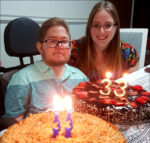Cell Therapy DT-DEC01 Showing Safety, Motor Gains in DMD Trial

DT-DEC01, Dystrogen Therapeutics’ experimental chimeric cell therapy for Duchenne muscular dystrophy (DMD), appears generally safe and improved muscle strength and motor function in the first three boys enrolled in a Phase 1 clinical trial.
Based on these positive results of the therapy’s low dose, with follow-up ranging from one to three months, the trial’s data and safety monitoring board cleared the testing of a pre-planned higher dose in a new group of patients.
“It’s very encouraging that we continue to see consistent, positive data from our investigational DT-DEC01 engineered cell therapy across several measures, as we know the community needs more options,” Maria Siemionow, MD, PhD, Dystrogen’s chief scientific officer, said in a press release.
“The improvements in functional measures at 1 and 3 months in participants from the low dose cohorts [groups] who received DT-DEC01 are distinctly different from what an age-matched, natural history group would predict with DMD,” Siemionow added.
“When coupled with the … encouraging safety profile seen to date, today’s results increase our confidence in DT-DEC01 and provide additional supportive evidence for this approach as we advance to the higher dose cohort into the next stage of clinical testing,” she said.
DMD is caused by the loss of dystrophin, a key protein for muscle strength, due to mutations in the DMD gene. Dystrophin deficiency leads to muscle weakness and wasting, also affecting the heart and its function.
Developed with Dystrogen’s proprietary cell engineering technology, DT-DEC01 involves ‘fusing’ myoblasts — muscle cell precursors — from a healthy donor with a patient’s own myoblasts in the lab to create dystrophin expressing chimeric (DEC) cells.
These cells contain the healthy cells’ ability to produce normal levels of dystrophin, while presenting the patient’s cell surface immune markers, allowing them to be transplanted back to the patient without risk of immune rejection.
This also eliminates the need for immunosuppressive treatment to reduce potential immune responses against transplanted DEC cells.
Lab-formed DEC cells are then transplanted into the patient’s bone marrow, from where they are expected to travel to muscle sites and ‘fuse’ with resident myoblasts to form muscle fibers that will subsequently be able to produce dystrophin.
As such, DT-DEC01 is thought to increase dystrophin levels and prevent further muscle damage, and to possibly restore muscle function in all DMD patients, regardless of their underlying DMD gene mutation.
Since the therapy is not based on genetic modification and does not uses viral carriers, it also is expected to be safer than gene therapies that have a risk of off-target mutations and immune responses against the viral carrier.
In preclinical work in a mouse model of DMD, this approach was shown to increase the number of healthy myoblasts and raise dystrophin levels, reduce inflammation, and significantly improve muscle strength and function. A similar DEC-based approach also improved heart function in this mouse model.
These promising findings prompted Dystrogen to launch a Phase 1 clinical trial to evaluate the safety, tolerability, and effectiveness of three increasing doses of the therapy in 10 boys, ages 5–18, with DMD.
The pilot study, which dosed its first patient early this year, aims to assess changes in the boys’ functional motor skills, range of motion, walking ability, upper limb function, muscle strength, and heart muscle health.
The trial is being conducted in Poland under hospital exemption, a special access program that allows the use of unapproved therapies under controlled conditions in cases of high unmet therapeutic needs.
Newly announced data concern one-to-three-month follow-up results for the first three patients given the lower dose of DT-DEC01 (2 million cells per kilogram). All carried different disease-causing DMD mutations.
Three months after treatment, a 7-year-old boy who was still able to walk showed improved muscle electrical activity, as assessed with electromyography, greater grip strength, and better walking ability. Increased step count, measured through an activity tracker, was also observed.
A 15-year-old boy who had lost his ability to walk showed greater activity level, improved grip and upper extremity strength, and had better lung function at two months post-treatment. Increased step count was also reported one month after treatment in a 6-year-old boy who was able to walk.
During this period, there were no reports of adverse events related to the therapy.
Based on these promising results, the trial will start to test a higher dose of DT-DEC01 (4 million cells per kilogram) in newly recruited patients.
“There are currently no approved treatments for people with DMD that result in a cure or significant attenuation of the disease — one that causes significant disability in boys and young men,” Siemionow said.







